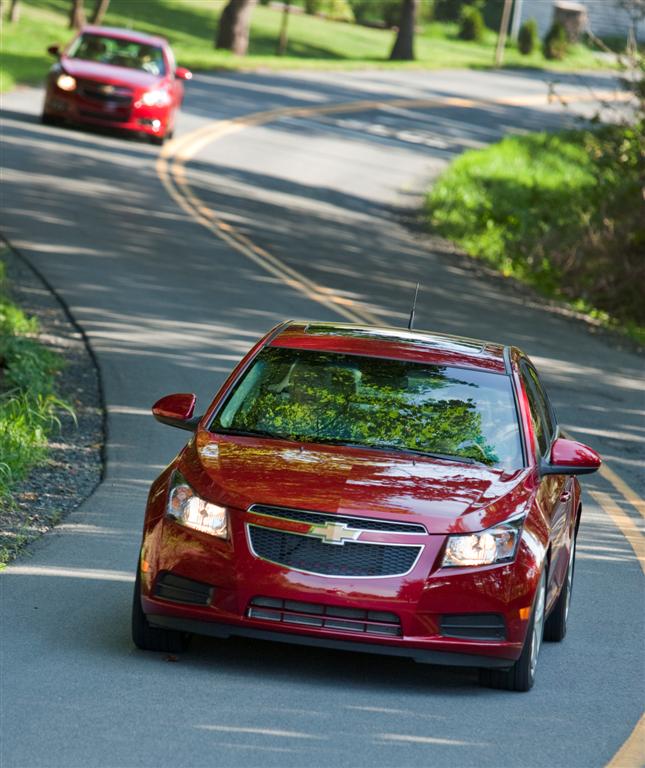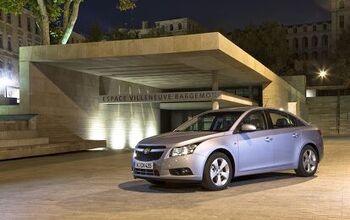Review: 2011 Chevrolet Cruze – Now With Comments!

I was born in 1971 and started actively reading about cars in 1976, subscribing to Car and Driver and absorbing the work of men such as LJK Setright, Gordon Jennings, and Gordon Baxter. Those men were waiting for America to create a truly outstanding small car, one that could meet the Germans (and, later, the Japanese) on equal ground and beat them in a fair fight. More particularly, since General Motors was the acknowledged leader of the American automotive industry, they were waiting for GM to create the Great American Small Car.
Those men are gone now, as dead as Julius Caesar and not nearly as well-remembered. I am standing here, waiting in their stead, waiting patiently for the Great American Small Car, waiting for General Motors to fulfill the promise they’ve made to us for nearly fifty years now.
The 2011 Chevrolet Cruze is a good car, although at least part of its goodness comes from the fact that it isn’t really that small. It’s well-positioned against the Civic and Corolla. I believe that it beats both of those cars in significant, measurable ways. This is what it is: a good car, a bold car, a car for which no purchaser need make an excuse or feel any concern. This is what it might be: great. That’s for the buyer to decide. This is what it is not: American.
You are looking at the Cruze’s not-so-secret weapon: an interior that represents a Cloverfield-sized leap past the competition. It’s part Cadillac CTS, part Buick LaCrosse, part Chevrolet Malibu, and unmistakably GM in the way the exterior does not quite manage to be. Forget the Civic or Corolla. From the touchable dash panels to the big, comfy seats, the Cruze is fitted-out to compare directly with Accords and Maximas. The interior is spacious. Visibility is outstanding. On the road, the Cruze is genuinely quiet — not from an overabundance of insulation, but from thoughtful design. The harsh, annoying frequencies disappear, allowing the stereo to shine even at low volume. Never before has a car of this size been so relaxing to run down the freeway for four adult passengers.
In this class, iPod integration matters more than raw power, and the Cruze shines here, offering fast, no-excuses access to my 138GB of music. The rest of the “HMI” doesn’t match up to Ford standards; in terms of usability and feature content, it’s closer to what you would expect to find in the Korean competition. Still, it’s at least in the ballpark with the class leaders.
Awww, look at the baby engine! This is the 1.4 Ecotec Turbo. GM is positioning this as the “upscale” engine in the range. It produces about the same horsepower as, but far more “area under the curve” than, the standard-equipment 1.8 normally-aspirated Ecotec. The ostensible reason for delaying the Cruze introduction in the United States was to make sure this engine was ready for prime time, although surely the massive expense of changing Lordstown from Cobalt to Cruze production also factored into that decision.
No matter. If you’d bought a Cruze last year with a 1.8, you would probably wish you had the 1.4 turbo instead. This is a sound, cheerful, strong-enough motor, producing a nice long plateau of torque from 1700rpm on and making it easy to drive on light throttle. In recognition of the fact that TTAC readers don’t necessarily care how quickly the big little Chevy can run down a two-lane, during my drive time I chose to focus on a different aspect of “performance”. Faced with a twisty, elevation-change-laden twenty miles of bad (meaning good) road, I gripped the wheel…
…drove the speed limit, maximized economy and smoothness, and was rewarded with an average of 36.8mpg. This wasn’t a freeway snooze drive; it was chock-full of marked 25mph switchbacks, big climbs, and plenty of descending, decreasing-radius stuff. Never did the Cruze feel out of breath despite the light throttle openings, and never did the engine feel inadequate.
The same cannot be said for the transmission. DSG and Powershift have made this torque-converter box obsolete in the class. While it offers a full six ratios compared to Toyota’s four, this is a transmission that is always in motion, always shifting, and always intruding on the experience. It should be junked, and soon. If you’re considering a Cruze, get the manual transmission. It wasn’t made available for us to drive, but it can’t be worse.
This new GM “world car” platform offers a “Z-link” rear torsion-beam suspension that seems to improve the so-called secondary ride a bit. This is a car that absorbs road imperfections very well, beating both the Civic and Corolla provided for comparison. That’s right: Chevrolet was confident enough to include two of the four heavy-hitters to the party. The Civic was a more enthusiastic vehicle, and far more fun to hustle along the back roads, but it cannot match the Cruze for features, space, fuel mileage, or interior ambiance. The Corolla has simply outlived its competitiveness, period. The Focus, had it been present, would have easily shown-up the Cruze on over-the-road pace and interface design but would have struggled with noise and interior quality perception. The Elantra would have been a tougher nut to crack, given that it is a massive improvement over its precedessor. Still, none of these cars can “waft” like the Cruze… and who would have thought that word would ever apply to a car that traces its spiritual lineage to the Chevette?
For drivers who are not particularly worried about over-the-road sportiness, the Cruze could very well be the current class leader, and it’s likely to hold that position at least until the next “Euro” Ford Focus arrives next year. For the first time in modern history, a Chevrolet compact car is legitimately the class of the field.
Unfortunately, it’s priced like the class of the field, too. The base car starts at $16,995 and features the 1.8 Ecotec coupled with a more-than-healthy dollop of airbags and other safety features. The top-of-the-line LTZ-RS rings the cash register for $23,300 or thereabouts and doesn’t have a navigation system at that price. Will cash have to be laid on the hood to move these cars?
The most interesting of the model variants is the mid-range “Eco”, which pairs the turbo 1.4 with a host of weight-saving and aero mods, including aerodynamic shutters behind the grille that close to optimize freeway fuel economy. Priced at $18,895, it is projected to clock 40mpg with the six-speed manual. I see no reason to disbelieve this claim. It may not be a Prius killer, but it takes the fight directly to the Civic Hybrid and carries the now-mandatory set of green-ish badges.
During the PR event in dreary Washington, DC, home of General Motors’ corrupt government owners and the mendacious lobbyists who pull their strings, we were continually reminded that the Cruze has been successfully sold in “sixty countries” so far. This is correct, and it’s troubling. To some degree, the Cruze is already old news upon its arrival here, the same way the Ford Fiesta has had a nice long run in Europe prior to visiting Ellis Island. Why?
The answer is simple: this is a Daewoo. My direct, repeated questions to GM personnel regarding the Cruze’s Korean ancestry were answered honestly but with perhaps too-scrupulous attention to detail. I was repeatedly told that “the architecture was engineered in Germany”, and I was repeatedly told about the “global nature” of the engineering, but the plain fact of the matter is that the Daewoo Lacetti was largely engineered, styled, and developed by Daewoo in Korea. It was then modified in some detail to become the Chevrolet Cruze. It’s a Korean car, and if it isn’t quite a Korean-market transplant like the Aveo, it’s very far from being a European design like the Ford Focus or VW Jetta.
The issue of American engineering for the Cruze hardly came up. In the modern era, GM seems to source its electronics in China, its major systems in Europe, and its brainpower in Korea. It’s smart business — TTAC readers know about China’s market and the limitless potential there — but for those of us who wanted an all-American small car to draw a line in the sand, there’s only disappointment.
The rest of you can buy a Cruze with a clear conscience. It’s built here, it’s feature-packed, it doesn’t lag behind the competition, and it’s likely to be a reliable, decent vehicle. That’s all this segment asks for. Anything else can be dismissed as the worthless dream of a wandering dreamer like myself, a pair of ragged claws scuttling across the floor of silent seas, wishing for the day that General Motors shows us a great American small car.

More by Jack Baruth
Latest Car Reviews
Read moreLatest Product Reviews
Read moreRecent Comments
- V8fairy Not scared, but I would be reluctant to put my trust in it. The technology is just not quite there yet
- V8fairy Headlights that switch on/off with the ignition - similar to the requirement that Sweden has- lights must run any time the car is on.Definitely knobs and buttons, touchscreens should only be for navigation and phone mirroring and configuration of non essential items like stereo balance/ fade etc>Bagpipes for following too close.A following distance warning system - I'd be happy to see made mandatory. And bagpipes would be a good choice for this, so hard to put up with!ABS probably should be a mandatory requirementI personally would like to have blind spot monitoring, although should absolutely NOT be mandatory. Is there a blind spot monitoring kit that could be rerofitted to a 1980 Cadillac?
- IBx1 A manual transmission
- Bd2 All these inane posts (often referencing Hyundai, Kia) the past week are by "Anal" who has been using my handle, so just ignore them...
- 3-On-The-Tree I was disappointed that when I bought my 2002 Suzuki GSX1300R that the Europeans put a mandatory speed limiter on it from 197mph down to 186mph for the 2002 year U.S models.






































Comments
Join the conversation
I currently own a 2005 Toyota Corolla, and I simply love that car. I am 6'2", and it fits me perfectly (as the driver, of course). HOWEVER, from what I'm reading about the Chevrolet Cruze, my eyes are starting to wander. I think it looks beautiful on the outside and the inside. Naturally, I would have to test-drive it first to make sure that it can fit a man of my stature, but so far, I'm feeling it, as the young people say. I hate large cars, and don't even try to sell me an SUV, and I thought that's all that Chevrolet could produce well, but now that the Cruze is on the scene, I might have to rethink that.
I looked at Cruze, briefly. I lost interest when I learned that I'd have to settle for the eco model to get stick shift. Would it kill GM to let me have a car with a clutch pedal in LTZ trim? Apparently it would. Cruze isn't anything like sporty, but a 5 speed would make the best of what's there.